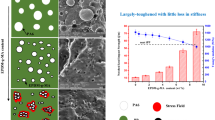Abstract
Hydroxyapatite particulate reinforced high density polyethylene composite (HA-HDPE) has been developed as a bone replacement material. The impact behavior of the composites at 37 °C has been investigated using an instrumented falling weight impact testing machine. The fracture surfaces were examined using SEM and the fracture mechanisms are discussed. It was found that the fracture toughness of HA-HDPE composites increased with HDPE molecular weight, but decreased with increasing HA volume fraction. Examination of fracture surfaces revealed weak filler/matrix interfaces which can debond easily to enable crack initiation and propagation. Increasing HA volume fraction increases the interface area, and more cracks can form and develop, thus decreasing the impact resistance of the composites. Another important factor for the impact behavior of the composites is the matrix. At higher molecular weight, HDPE is able to sustain more plastic deformation and dissipates more impact energy, hence improving the impact property.
Similar content being viewed by others
References
W. Bonfield, M. D. Grynpas, A. E. Tully, J. Bowman and J. Abram, Biomaterials 2 (1981) 185.
W. Bonfield, J. C. Behiri, C. Doyle, J. Bowman and J. Abram, in “Biomaterials and Biomechanics 1983”, edited by P. Ducheyne, G. Van der Perre and A. E. Aubert (Elsevier Science Publishers B.V., Amsterdam, 1984) p. 421.
W. Bonfield, J. Biomed. Eng. 10 (1988) 522.
W. Bonfield, in “Polymers in Medicine III”, edited by C. Migliaresi et al. (Elsevier Science Publishers B.V., Amsterdam, 1988) p. 139.
R. N. Downes, S. Vardy, K. E. Tanner and W. Bonfield, Bioceramics 4 (1991) 239.
K. E. Tanner, R. N. Downes and W. Bonfield, Brit. Ceram. Trans. 93 (1994) 104.
J. L. Dornhoffer, Laryngoscope 108 (1998) 531.
J. Abram, J. Bowman, J. C. Behiri and W. Bonfield, Plast. Rubber Proc. Appl. 4 (1984) 261.
M. Wang, D. Porter and W. Bonfield, Brit. Ceram. Trans. 93 (1994) 91.
J. Suwanprateeb, K. E. Tanner, S. Turner and W. Bonfield, J. Mater. Sci: Mater. Med. 6 (1995) 804.
J. Suwanprateeb, K. E. Tanner, S. Turner and W. Bonfield, J. Biomed. Mater. Res. 39 (1998) 16.
J. Suwanprateeb, K. E. Tanner, S. Turner and W. Bonfield, J. Mater. Sci: Mater. Med. 8 (1997) 469.
P. T. Ton That, K. E. Tanner and W. Bonfield, J. Biomed. Mater. Res. 51 (2000) 453.
P. T. Ton That, K. E. Tanner and W. Bonfield, ibid. 51 (2000) 461.
P. J. Hogg, J. Behiri, A. Brandwood, J. Bowman and W. Bonfield, Proc. Comp. in Biomed. Eng. (Plastic and Rubber Institute, London, 1985) 29 1
K. Friedrich and U. A. Karsch, J. Mater. Sci. 16 (1981) 2167.
H. H. Kausch, Ph. Beguelin and M. Fischer, Mech. Compos. Mater. 36 (2000) 177.
R. Walter, K. Friedrich, V. Privalko and A. Savadori, J. Adhesion 64 (1997) 87.
Q. Fu and G. Wang, Polym. Eng. Sci. 32 (1992) 94.
Z. Bartczak, A. S. Argon, R. E. Cohen and M. Weinberg, Polymer 40 (1999) 2347.
J. Jancar, A. T. Dibenedetto and A. Dianselmo, Polym. Eng. Sci. 33 (1993) 559.
P. K. Mallick, in “Comprehensive Composite Materials, Vol. 2, Polymer Matrix Composites” (Elsevier Science Ltd., Amsterdam, 2000) p. 291.
E. Fekete, S. Z. Molnar, G. M. Kim and G. H. Michler, J. Macromol. Sci.-Phys. B38 (1999) 885.
S. Deb, M. Wang, K. E. Tanner and W. Bonfield, J. Mater. Sci: Mater. Med. 7 (1996) 191.
F. J. Guild and W. Bonfield, Biomaterials 14 (1993) 985.
F. J. Guild and W. Bonfield, J. Mater. Sci: Mater. Med. 9 (1998) 497.
A. Savadori, M. Scapin and R. Walter, Macromol. Symp. 108 (1996) 183.
J. Suwanprateeb, Polym.-Plast. Technol. Eng. 39 (2000) 83.
S. C. Tjong, R. K. Y. Li and T. Cheung, Polym. Eng. Sci. 37 (1997) 166.
Author information
Authors and Affiliations
Corresponding author
Rights and permissions
About this article
Cite this article
Zhang, Y., Tanner, K.E. Impact behavior of hydroxyapatite reinforced polyethylene composites. Journal of Materials Science: Materials in Medicine 14, 63–68 (2003). https://doi.org/10.1023/A:1021553504549
Issue Date:
DOI: https://doi.org/10.1023/A:1021553504549




